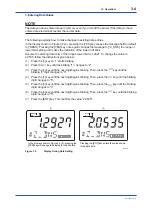
<2.
Installation, Wiring and Piping>
2-5
IM 11T03E01-51E
2.2
Installing the Converter
2.2.1
Selecting the Location
l
Ease of operation
Select a location where you can easily view the readings on the display and work with the
keys. Installing the converter closer to the detector will ease your maintenance work, including
calibration.
l
No corrosive gases
Corrosive gases are not desirable because they may damage the electrical components in the
converter.
l
Slight mechanical vibration
Although the converter is vibration-resistant, vibration may loosen the connections of the external
wiring.
l
No exposure to direct sunlight
Exposure to direct sunlight may raise the temperature in the converter to abnormal levels, and
should therefore be avoided. Note that such abnormal temperature levels can also result from
heat irradiated from high-temperature equipment around the converter. If the converter is likely to
receive direct sunlight and the temperature in the converter will likely exceed the operating limits,
attach a hood (optional).
l
Humidity maintained between 5% and 95%RH.
Avoid choosing a location that is likely to be exposed to abnormally high or low humidity over a
prolonged period. It is recommended that the converter be used at a humidity between 25% and
85%RH.
l
No exposure to rainwater
Even though the converter is rainproof, whenever possible install it where it is protected from
water splashes. The reasoning for this is that the converter cover may need to be removed for
maintenance or for other reasons
l
Altitude of installation site is lower than 2,000 m.
Summary of Contents for GD402G /M1
Page 21: ...Blank Page ...
Page 37: ...Blank Page ...
Page 81: ...Blank Page ...
Page 115: ...Blank Page ...
Page 159: ...Blank Page ...
Page 167: ......
Page 169: ......
Page 171: ...Blank Page ...






























